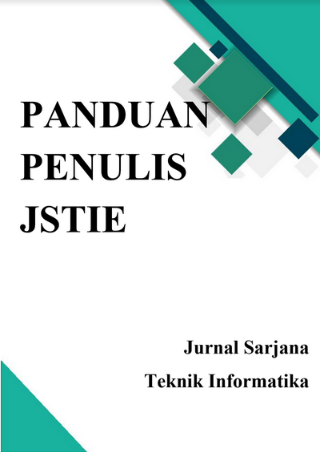MODEL PENENTUAN STATUS GIZI BALITA DI PUSKESMAS
DOI:
https://doi.org/10.12928/jstie.v1i1.2552Abstract
Status gizi balita merupakan faktor penting yang harus diperhatikan karena masa balita merupakan periode perkembangan yang rentan dengan gizi. Upaya pemerintah dalam perbaikan gizi balita dengan memantau status gizi balita di setiap wilayah kerja Puskesmas. Tujuan penelitian ini adalah membuat aplikaaasi Model Penentuan Status Gizi Balita Di Puskesmas.
Penilaian status gizi dengan menggunakan metode logika fuzzy dengan menghitung nilai derajat keanggotaan sehingga menghasilkan status gizi yang lebih akurat. Tahap pengembangan yang digunakan dalam tugas akhir ini, menggunakan model sequensial Linier yang diawali dengan tahap analisis sistem yaitu analisis deskripsi kebutuhan sistem, pembuatan diagram konteks, data flow diagram, entity relationship diagram, dan tahap perancangan sistem yang meliputi spesifikasi proses, perancangan mapping tabel dan perancanggan menu antarmuka. Setelah tahap perancangan selesai maka dilanjutkan tahap implemetasi dengan Borland Delphi 7 sebagai tool merancang desain sistem dan MySQL sebagai database.
Hasil penelitian ini berupa aplikasi model penentuan status gizi balita di Puskesmas yang hasilnya dapat membantu petugas gizi untuk menentukan status gizi balita di Puskesmas agar lebih efektif dan akurat.
Kata kunci : Status gizi, Model penentuan, balita, fuzzy.References
Depkes, RI, 2008. Analisis Status Gizi dan Kesehatan Masyarakat. Jakarta.
Arsad, RA, 2006, Penilaian Status Gizi Anak, Staf Dinas Kesehatan, Kabupaten Polewali Mandar, Medan.
Khosman, Ali., Prof Dr. Ir, 2008, Mengetahui Status Gizi Balita, Kepala Bagian Terapan Gizi, Institut Pertanian Bogor, Bandung.
Khoiri, Idah Fitri, 2009, Status Gizi Balita Di Posyandu Kelurahan Padang Bulan Kecamatan Medan Baru, Skripsi, Universitas Sumatera Utara, Medan.
Amelia, Rima, 2007, Sistem Pencatatan Dan Pelaporn Bulanan Status Gizi Balita Di Puskesmas, Bandung.
Supariasa. 2001. Penilaian Status Gizi. Jakarta. EGC
Suryadi, K dan Ramdhani, M.a., 1998, Sistem Pendukung Keputusan Suatu Wacana Struktural Idealis dan Implementasi Konsep Pengambilan Keputusan, Cetakan Pertama . PT Remaja Bandung.
http://library.gunadarma.ac.id, Pengantar Sistem Pendukung Keputusan(DSS)
http://Ilmukomputer.com, Database Management Sistem
http://geocities.com, Sistem Pendukung Keputusan Metode Fuzzy logic
Downloads
Published
Issue
Section
License
License and Copyright Agreement
In submitting the manuscript to the journal, the authors certify that:
- They are authorized by their co-authors to enter into these arrangements.
- The work described has not been formally published before, except in the form of an abstract or as part of a published lecture, review, thesis, or overlay journal. Please also carefully read Journal Posting Your Article Policy.
- The work is not under consideration for publication elsewhere.
- The work has been approved by all the author(s) and by the responsible authorities – tacitly or explicitly – of the institutes where the work has been carried out.
- They secure the right to reproduce any material that has already been published or copyrighted elsewhere.
- They agree to the following license and copyright agreement.
Copyright
Authors who publish with Jurnal Sarjana Teknik Informatika agree to the following terms:
- Authors retain copyright and grant the journal right of first publication with the work simultaneously licensed under a Creative Commons Attribution License (CC BY-SA 4.0) that allows others to share the work with an acknowledgement of the work's authorship and initial publication in this journal.
- Authors are able to enter into separate, additional contractual arrangements for the non-exclusive distribution of the journal's published version of the work (e.g., post it to an institutional repository or publish it in a book), with an acknowledgement of its initial publication in this journal.
- Authors are permitted and encouraged to post their work online (e.g., in institutional repositories or on their website) prior to and during the submission process, as it can lead to productive exchanges, as well as earlier and greater citation of published work.







